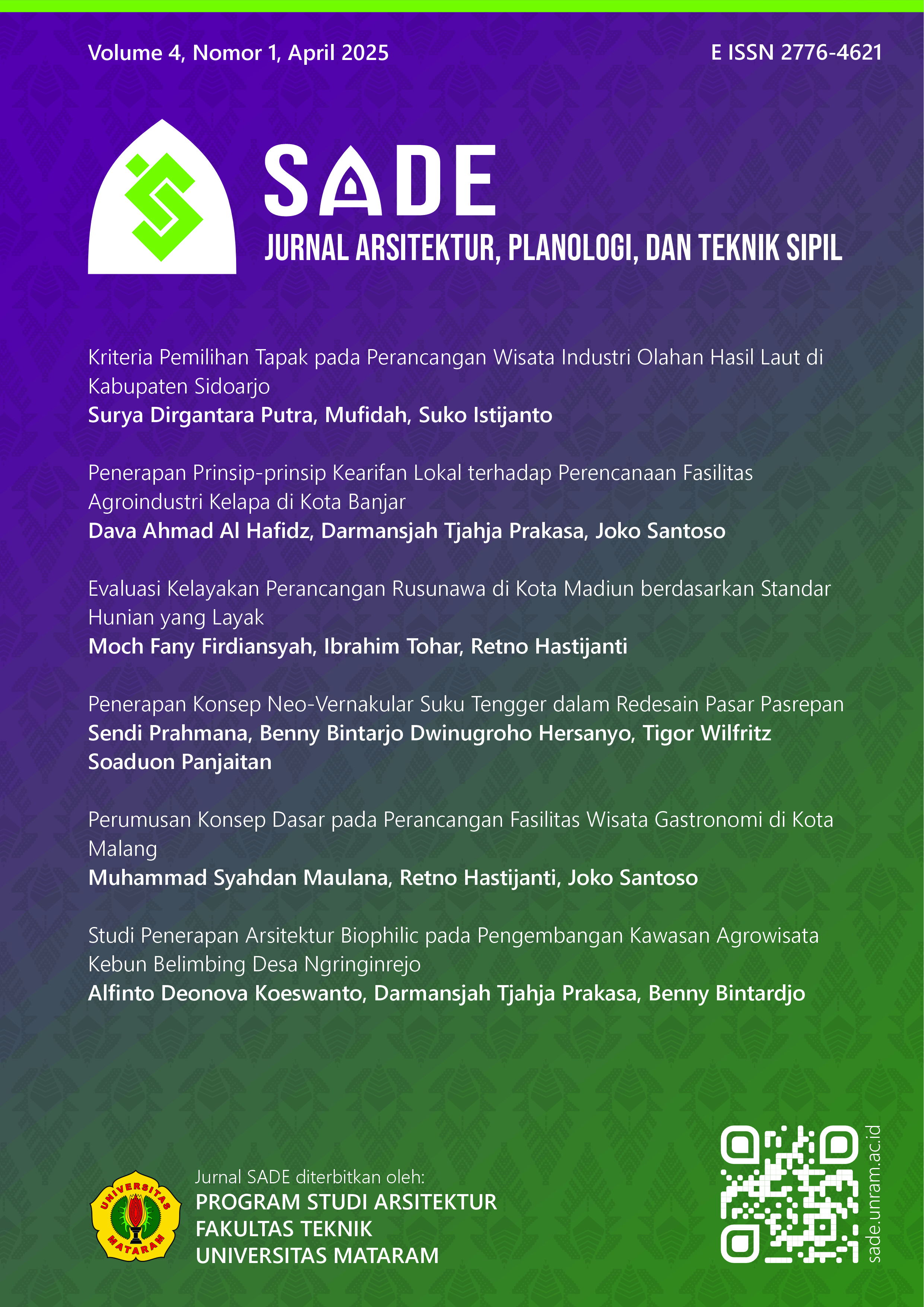pene Application of the Neo Vernacular Concept of the Tengger Tribe in the Redesign of the Pasrepan Market
DOI:
https://doi.org/10.29303/sade.v4i1.120Keywords:
Redesain, Warisan Budaya, Destinasi Wisata Belanja, Arsitektur Neo-Vernakular, Suku Tengger, Pasar PasrepanAbstract
Neo-Vernacular architecture, as a response to rigid modernism, offered a more holistic approach to building design. This concept integrates traditional, cultural and environmental values into modern design. This research aims to apply the Neo-Vernacular concept of the Tengger Tribe in the redesign of Pasrepan Market.
Pasrepan Market, as the center of economic and social activity for the Tengger community, has great potential to become a unique tourist icon. By adopting the roof shape of a traditional Tengger house combined with modern materials such as light steel, this market design not only respects cultural heritage, but also increases the efficiency and durability of the building. Apart from that, the use of typical Tengger batik ornaments on the building facade further strengthens local identity and creates a distinctive atmosphere.
It is hoped that this research can become a reference in creating buildings that are not only aesthetic, but also environmentally friendly and uphold local cultural values. By combining traditional and modern elements in the redesign of Pasrepan Market, it is hoped that it can become an example for the sustainable development of other traditional markets.
Kata kunci: Neo-Vernacular Architecture, Tengger Tribe, Pasrepan Market, redesign, local culture, cultural heritage, tourism.
References
Aska. (2017). Pengertian arsitektur neo vernakular. Retrieved https://www.arsitur.com/2017/11/pengertian-arsitektur-neo-vernakular.html
Damanik, J., & Weber, H. F. (2006). Perencanaan ekowisata: Dari teori dan aplikasi. Yogyakarta: PUSPAR UGM dan Andi Yogyakarta.
Ditamei, S. (2022). Pengertian Pasar Tradisional, Contoh, dan Kegiatannya.
Fajrine, G., Purnomo, A. B., Juwana, J. S., Jurusan, M., & Fakultasteknik, A. (2017). Penerapan Konsep Arsitektur Neo Vernakular Pada Stasiun Pasar Minggu. 85 –91
Ghassani, B. G., & Erwindi, C. (2020). Persepsi visual dalam rancangan pusat belanja daring dan luring. Jurnal Sains dan Seni ITS, 8(2), G40–G44.https://doi.org/10.12962/j23373520.v8i2.46404
Gischa, S. (2020). Pasar Tradisional: Pengertian, Ciri, dan Jenisnya
Jencks, C. A. (1977). The Language of Post -Modern Architecture Charles a. Jencks Academy Editions • London Contents.
Peraturan Presiden RI No. 112/2007 Tentang Penataan Dan Pembinaan Pasar Tradisional, Pusat Perbelanjaan Dan Toko Modern
Putra, T. P. (2013). Pengertian arsitektur neo vernakular. Retrieved https://www.scribd.com/doc/135985062/Pengertian-Arsitektur-Neo-Vernakular#
Downloads
Published
Versions
- 2025-04-30 (3)
- 2025-04-30 (2)
- 2025-04-30 (1)
How to Cite
License
Copyright (c) 2025 sendi prahmana, Benny Bintarjo Dwinugroho Hersanyo, Tigor Wilfritz Soaduon Panjaitan

This work is licensed under a Creative Commons Attribution-ShareAlike 4.0 International License.
Hak cipta dan lisensi setiap artikel yang diterbitkan di situs jurnal dipegang penuh oleh penulis artikel dan tidak boleh disalahgunakan, dilipatgandakan, serta dipublikasikan diluar situs SADE untuk kepentingan tertentu tanpa persetujuan dari penulis.















